Darker Than Blacklist
Yeah, it’s that most dreaded time of year once again. You know the kind. It’s the type of showing that actually makes you slightly ashamed of being an anime fan. Yet while this evening is usually devoted to the garbage water that exists beneath the bottom of the barrel, this year’s Blacklist Night is by far the tamest in at least 5 years. Then again, we’ve already shown Aquarion Evol, Symphogear, and Kill Me Baby, so it’s mathematically impossible to do worse (way to program by theme, Jack!). That said, the evening is instead filled with fan service, enough that the club no longer provides tissues (a lot of people had allergies this spring). Read on to find out why so many of our members died during the drinking game.
MajiKoi (Oh! Samurai Girls)

AKA School Rumble
Kawakami City is famous for its strong dedication to its samurai ancestors. At Kawakami Academy, disputes are settled the old fashioned way: with duels and/or full-scale school-wide battles. However, Yamato Naoe is a thinker, not a fighter. As such, he acts as a head strategist whose plans are enacted by his close friends and a small harem, all of whom he shares a close and extended history. Yet Yamato has eyes only for the powerful Momoyo, who has little-to-no interest in his unrequited love. Together they battle other classes, go to school, and occasionally get tangled up with cyborgs and gunrunners who have evil plans for Japan.
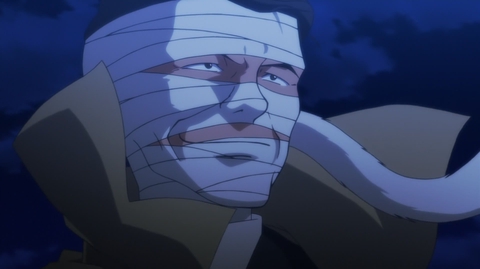
Especially this guy…
Ah, the classic bait-and-switch. No other tactic is so heavily used in anime, except fan-service. So imagine my distaste when I was given a glimmer of hope by the first 2 episodes, only to have said hopes ground into a fine dust by the proceeding 10. Though the first episode is fairly disorienting (since it starts in the middle of a school-wide war in the middle of a forest clearing), the main characters are steadily introduced with trademark grand entrances. Unsurprisingly, the guys are uninteresting, Yamato displays his main character status, and the harem shows off their super-powers. Still, the war itself is interesting, with Yamato’s army low on resources still managing to force victory through clever management and various tactics (mostly psychological).
Then comes the rest of the series, and it sadly cannot even slightly compare to the first episode. Yes, it’s an eroge adaptation. Yes, everyone knows one another, and yes, the harem girls all love Yamato. Yet he has made it painfully clear that he only wants Momoyo, who basically won’t love him until he is the most alpha of males. Usually, this would as least keep the story moving along, since everyone has known the main character for nearly a decade and that his decision is final. This would spare the audience from any farcical character development, since he already has his unintended harem. But the series doesn’t move on, it doesn’t evolve, and the characters can’t take a hint, a shout, or an outright “NO!!!” Hot spring epsiodes, endless foiled attempts at unrequited love, and pointlessly episodic plots drive the series off a cliff and deep into the earth. What ensues is vapid in every sense of the word, and it’s outraging that everything the series was set up to be in the first episode is an absolute lie. Any humor, wit, or character development is shot into oblivion the moment it deviates from the show’s crash course. Everything else is fan-service, pure unadulterated fan-service, and since it’s all without payoff, the series is all the more frustrating.
Majikoi’s animation is the definition of middling. The first episode ate what little animation budget there was, mixing in some fluid action with the stills. Even midway into the series, almost all of the action scenes are just stills and pans and panning stills. The director prioritizes saving the fan-service animation as the last to be degraded, and as such it remains good to decent for the majority of the show. Then again, most of the show IS blatant fan-service, but at least the characters don’t have to contort themselves for the viewers’ “entertainment.” The soundtrack is just a poor imitation of other, better soundtracks. Dramatic scenes have somewhat dramatic music, and the same follows for lighthearted, serious, and comedic scenes. Nothing is memorable or even noteworthy, so the director was smart for keeping the volume low.
Majikoi is a show that’s trifling, even for an eroge adaptation. Any interest generated by the first episode evaporates halfway through the second episode, never to return. It just lacks any sort of entertainment value from that point onward. Even if you’re watching this for the fan-service, other shows have better character designs, better fan-service and better payoff. It’s a waste of time in every way. Consider it relegated to the DEEN’s List.
Maken-Ki! Battling Venus
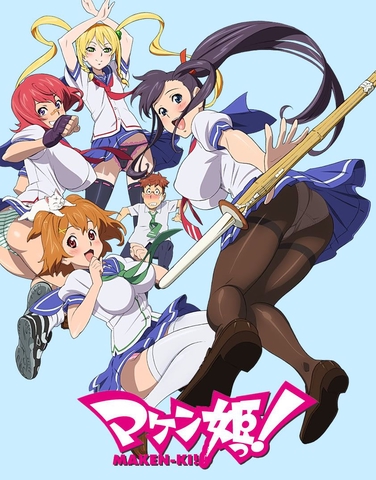
And you thought Majikoi was bad…
Takeru Ohyama is an average young male pervert. Since elementary school, he has parted ways from his childhood friend Haruko Amaya and gone off to a boarding middle school, while Haruko has started attending the secretive Tenbi Academy and has even become the student council vice president. The school has just gone co-ed, and conveniently they will both attend the same school this year. However, Tenbi Academy is a place where combat and magic is used to settle rather trivial matters. As is tradition, every student is assigned either an artifact or supernatural weapon called a Maken, based on their unique skillset and ability. Unfortunately, Takeru is not able to be assigned a Maken, which is otherwise impossible. It doesn’t take him long to make friends and enemies, and they all want to live in his dorm. Eventually, Takeru decides to join the Kenkeibu, a group that basically acts as referees and peacekeepers during the Maken battles.

Also as hot springs doujinshi fuel.
By far the biggest offender of the evening, Maken-Ki! strives to appeal to the lowliest faction of the lowest common denominator. Somehow this moron gets transferred into an otherwise super-secret school where everyone else fights with sacred objects and special abilities to “solve” the most meaningless of disputes. While this in and of itself deflates the show’s premise, the school faculty strongly encourages this behavior. If all this was going towards training the students for a loftier purpose, then it could possibly be justified, but otherwise the story’s backdrop just reeks of wasted potential. As for character development, it’s as much as you’d expect from an ecchi comedy fighting anime, which is incredibly little. That’s not surprising, but since this show can’t just be a porno film, you’d expect at least something to pass the time between fan service shots.
However, odds are strong that viewers of Maken-Ki! aren’t interested in a story at all, which is good because there’s very little story to be had. Instead, there’s fan service: really, REALLY awkward fan service. Many of the NPC’s could just as easily be replaced with a series of misshapen mannequins, since their only purpose is to temporarily arouse Takeru. Any authoritative figure in the series is also (conveniently) female, which means they are all instantly undermined by the painful forced attempts at fan service. This includes zooming back shots, physical examinations, and extra-short mini-skirts combined with over-the-top fighting. Unfortunately, the fighting animation isn’t very good either. It’s pretty much just ugly guys poorly fighting over-athletic women, and the Takeru and the Kenkeibu needlessly intervening. One point of interest is the strangely over-animated “fighting background” that appears during every fight. This seems to be a continuation of a troubling trend started by C3, and it has carried over to other shows like Nyarko-san. Viewers don’t care about the background for a fight, they care about the fight. Yet for some reason, animators have decided to focus on everything but the fighting animation, and it certainly shows here. Meanwhile, the music is generic and forgettable, and the voice acting is the same drivel heard from a thousand preceding and proceeding ecchi anime. In general, Maken-ki! knows its wretched place in the world, but even then, there is no interest in creating appealing artwork in the one area it is supposed to. Enjoy your stay on the DEEN’s List.
High School DxD

Short for Dungeons and DUNGEONS!
The story follows Issei Hyōdō, a dim-witted, lecherous second-year high school student who remains unable to find a girlfriend, even at his all-girls high school that just recently turned co-ed. Just when he gets his first date ever, the girl he’s with turns out to be a Fallen Angel, who kills him on the spot. However, Issei becomes reincarnated as a devil, thanks to the president of the school’s Occult Studies Club, Rias Gremory. As it so happens, Rias is actually a high-level demon and her fellow club mates are her demon subjects. From that day forward, he serves as an underling of Rias, training to become a faithful and dependable servant.
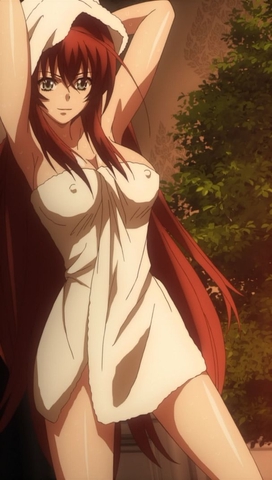
And why wouldn't he?
Of all the Blacklist anime I’ve ever had to review, High School DxD is by far the most tolerable, extending even to the inconceivable level of “decent.” Yes, it is a supernatural anime, and yes it is generic, and yes it does have a lot of fan service. Yet there’s something about it that keeps it from being terrible.

But I can't quite put my penis on it.
Actually, the main characters have a fair amount of depth and complexity. Rias is obviously powerful and highly intelligent, but she is also equally loyal to her subjects as they are to her. She also has a sensitive side which surfaces for only a second here and there. Rias’s subjects also have some small character development, when it is convenient. The fact that demon clans, such as the Gremory clan, are beset on all sides gives a purpose to possessing great power: they either use it to strengthen and defend themselves or they die. Of course, the series does have a bit of a bias, casting the demons as just trying to survive, while the Fallen Angels are just overpowered jerks, who have nothing better to do than troll demons and useful humans. However, both sides can be accused of vapid preening and posturing, which just accentuates the grandiose atmosphere of the series.
As for Issei, he follows the main character archetype pretty well: starts weak, gets pummeled, finds conviction, powers up, and beats the bad guy. Between fights, he performs the duty of every other demon: find people to make contracts with. This makes his role in the show seem more like a comic parody of Viper GTS (if that’s even possible). That said, Issei is always the one stuck with the stranger summoners:
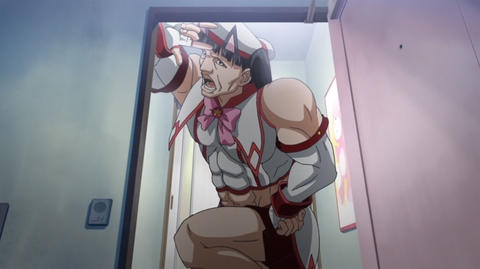
Have you been working out, Gene?
In the meantime, he develops a friendship (though not quite girlfriend-ship) with, of all people, a would-be nun named Asia. They have some distinct chemistry in the show’s first arc, including the fact that they both possess an ability called “Sacred Gear.” The ability works in different ways for different people, but ultimately such wielders are shunned and later snatched up by either the Demons or the Fallen Angels. In Asia’s case, she gets exploited by the Fallen Angel that first killed Issei and a psychopathic young priest named Freed.
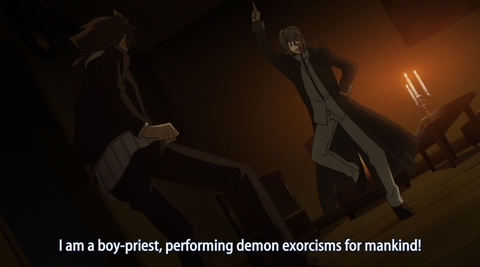
Apparently the younger priests are, the more Straight they are.
Asia has a fair amount of character development as well, since Issei views her (and to a small extent Rias) as a potential love interest, so she gets a good amount of screen time. Unfortunately, after the conclusion of the first arc (where she too is reincarnated as a demon under Rias’ care), she starts to act pretty derpy. In any case, there’s a remarkable amount of character interaction and background story all within the first 5 episodes of what is supposed to be just another shameless anime. With any luck, the plot will remain interesting, less it need be enhanced anymore by PLOT.
The animation for this series is also surprisingly well done. The background artwork is decent (that aspect alone puts the show a mile above other Blacklisted anime). The battles, while not particularly action-packed, are well detailed. The story also makes frequent reference to the age-old game of chess, stressing the strengths and weaknesses of each character and the eventual importance of their individual and collective roles. The transition artwork, such as the teleportation sequences, are also very well done. Of course, what ecchi anime is complete without the character designs. Aside from covering every female archetype and breast size, the designs and anatomical ratios are very accurate (if not necessarily realistic). Even during fighting scenes, the designs remain consistently polished. It’s not difficult to see that people had a fun time animating Rias and company.
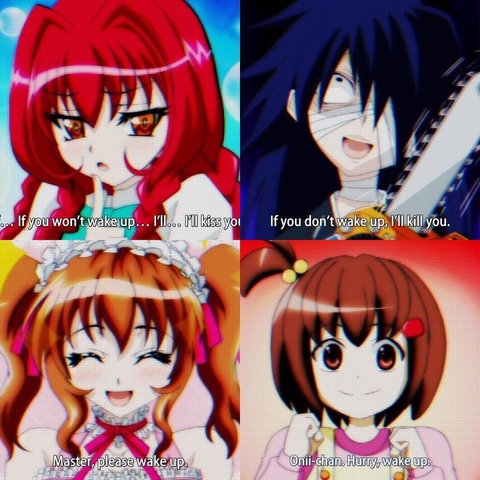
But I guarantee they had more fun designing that alarm clock.
However, the main point of controversy is, of course, the fan service. Yes, there is a metric ton of it in this show, and yes a great deal (if not all) of it is shameless. What separates this particular series from every other lame ecchi series out there is that almost every second of visual fan service is covered with purposeful audio that at least moves the story along. In this sense, every episode is more of a plot with benefits, something that can rarely be said about most ecchi anime, or even many generic non-ecchi anime.
The music and voice acting are also unexpectedly good. The voice actors always remain in character, regardless of whether the scene calls for them to be serious, coy, anger, or comical. The background music is strictly an orchestral affair, dominated by stringed instruments. The overall tone is one of melancholy, which matches the refined and lonely setting of the Occult Studies clubhouse. Only the OP is guitar, a generic rock ballad, but it still helps to set the mood of the series. Unfortunately, the ED sounds out of place, instead reminding the audience that this is still a silly ecchi show, despite every other aspect of the series trying to convince the viewer otherwise. If you’re in the mood for something that’s easy on the brain, and even easier on the eyes, then check out High School DxD, a show that (more often than not) rises to the occasion.
Come back next time, as I review the sequels that even Father Time forgot.